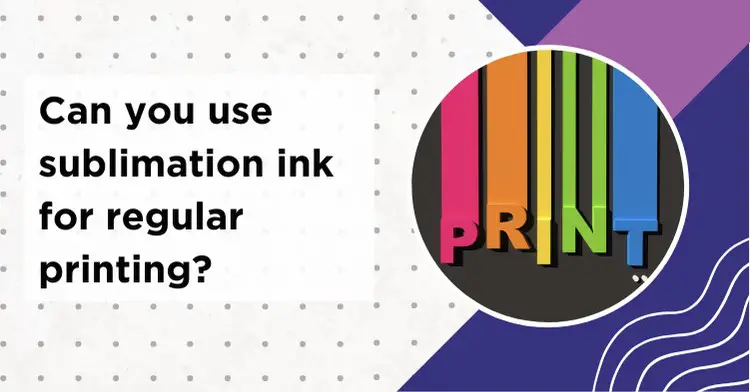With sublimation ink, you can print great designs on items like shirts and mugs. But have you ever wondered if you can use it for regular printing jobs? Many people are curious about this. In this article, we’ll explore the question: Can you use sublimation ink for regular printing?
On the one hand, sublimation ink can be used to print with conventional inkjet printers on ordinary office paper. They do not wash off with water and behave when printing the same as any other pigment sublimation ink.
However, the print quality on plain paper will be much worse than on special paper with the CISS ink system. Plain paper is not capable of transmitting full color, so the colors in the image will be less saturated, and the quality of the final image will be low. This is because ordinary office paper absorbs most of the sublimation ink, which reduces the print quality.

Thus, the use of sublimation ink for conventional printing is possible, but not recommended, as this will lead to a deterioration in print quality. For best results, it is better to use special paper with a CISS ink supply system.
Contents
Can You Use Sublimation Ink For Regular Printing: Points to Consider
- Sublimation ink is not suitable for conventional printing, as it is intended for use in sublimation printing, which is different.
- Sublimation ink has a different formula that does not allow it to be properly absorbed by ordinary paper, which can lead to poor print quality and incorrect color display.
- The use of sublimation inks for conventional printing is also inefficient and expensive. Sublimation ink tends to be more expensive than conventional ink for reasons like specialized use, quality, and durability.
For conventional printing, it is better to use conventional inkjet or laser printers with the appropriate ink.
If you need to print on a substrate, it is better to use special sublimation printers with sublimation ink to achieve the best results.
Printing With Regular Ink On A Sublimation Printer
Sublimation printers can print with ordinary pigment ink. However, there are several points that need to be taken into account:
Sublimation printers are designed only to work with sublimation inks that have a special coating on the surface, such as polyester.
Conventional ink is not designed to be applied to sublimation paper or transferred to a substrate properly and may not adhere well to sublimation paper.
The use of conventional ink in special sublimation printers may cause damage to the print head and internal components of the inkjet printers, and attempts to use them may damage the printer model.
In addition, the use of conventional ink on sublimation paper or printers is not recommended by the manufacturer and may void the warranty on the printer.
To achieve the best results and to avoid possible harm, it is very important to always use ink suitable for this type of inkjet printers and follow the manufacturer’s recommendations and standards.
How is Sublimation Ink Different From Regular Ink?
Sublimation ink and ordinary ink have significant differences from each other. Sublimation ink is intended for use in “sublimation printing”, in which the image is transferred from paper to a substrate (for example, fabric or metal) using heat and pressure. This process requires ink that can pass from a solid state to a vapor state, bypassing the liquid phase.
Unlike sublimation inks, conventional inks are used in conventional printing processes such as inkjet and laser printing. They consist of water, pigments, and dyes dissolved or suspended in a liquid medium and intended for absorption into the surface of the substrate, for example, transfer paper.
However, the main advantage of sublimation inks is that they provide bright, persistent colors that do not fade after repeated washing or exposure to sunlight. This is because the ink does not just lie on the surface of the substrate, but penetrates its structure. Sublimation printing also allows you to print full-color images of photographic quality on a wide range of substrates, such as textiles, ceramics, and metals, which makes it a universal solution for various printing tasks.
If you are looking for high-quality and durable prints, then sublimation ink is what you need. They provide bright and persistent colors that do not fade and allow you to print on a wide range of substrates, which makes them a universal solution for various printing tasks.
Why Does My Regular Printer Not Support Sublimation Printing?
Your everyday printer isn’t built for sublimation printing because they work in different ways. Sublimation printing needs special ink that turns into a gas when heated and sticks to things like shirts or mugs. Regular printers use ink that just dries on paper, so they can’t do the cool tricks that sublimation printers can
FAQs
Can you switch back and forth between sublimation ink and regular ink?
No, you cannot switch back and forth between sublimation ink and regular ink in the same printer without thoroughly cleaning the printer system in between, as the two types of ink are designed for different printing processes. Mixing them without proper cleaning can damage your printer and produce poor-quality prints.
Is sublimation ink different from regular ink?
Sublimation ink is special because when you heat it, it turns directly into a gas and sticks to things like shirts or mugs. On the other hand, regular ink is made to dry on paper the usual way we see prints on documents or photos.
What happens if you use sublimation ink on regular paper?
If you use sublimation ink on regular paper, it won’t dry properly and will likely smudge or spread because it needs heat to bond correctly. Regular paper isn’t designed to handle the unique way sublimation ink sets, so you won’t get a clear or lasting print.
Conclusion
Sublimation ink works great for colorful prints on things like shirts and mugs. But if you use it for normal printing, you’ll get messy results and weird colors. It’s important to use the right ink for the right job. Stick with regular ink for regular prints, and sublimation ink for special stuff!

Emily loves making things special.
She’s also a mom and a wife who enjoys crafting and runs a small business from her home. She knows that the little things can make a house feel like a warm and loving home. This belief has led her to explore the exciting world of sublimation, a crafty way to add a personal touch to just about anything. Her website shares valuable information about sublimation, her crafty ideas, and tips.


